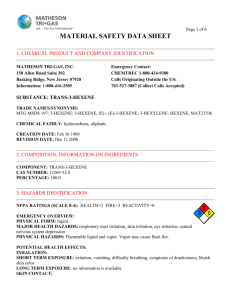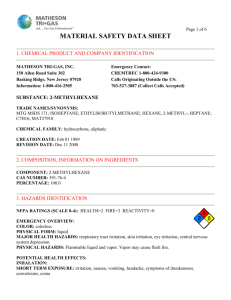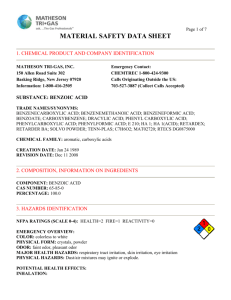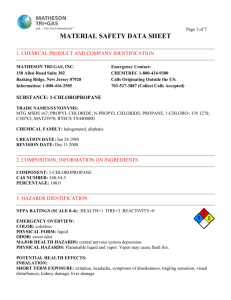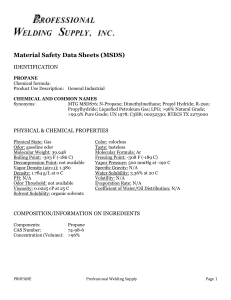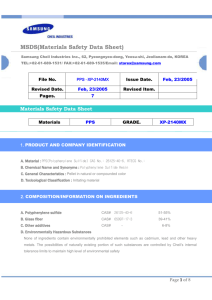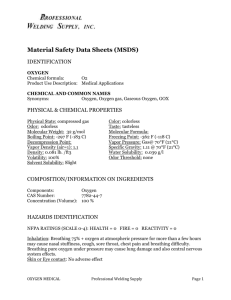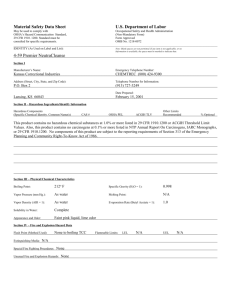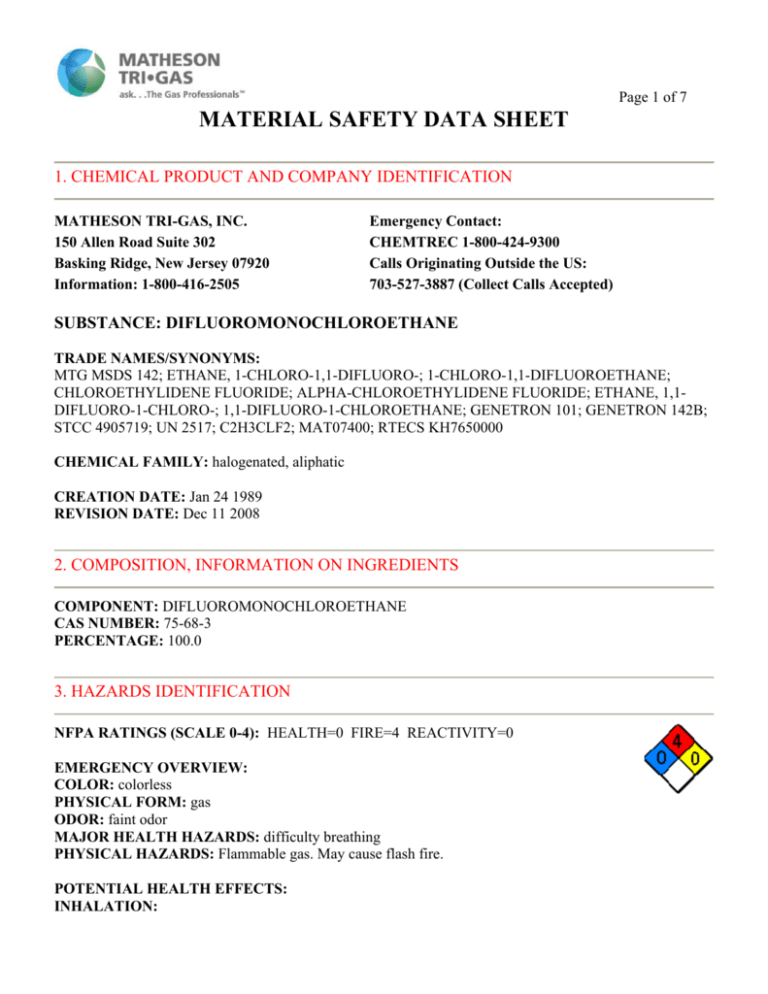
Page 1 of 7
MATERIAL SAFETY DATA SHEET
1. CHEMICAL PRODUCT AND COMPANY IDENTIFICATION
MATHESON TRI-GAS, INC.
150 Allen Road Suite 302
Basking Ridge, New Jersey 07920
Information: 1-800-416-2505
Emergency Contact:
CHEMTREC 1-800-424-9300
Calls Originating Outside the US:
703-527-3887 (Collect Calls Accepted)
SUBSTANCE: DIFLUOROMONOCHLOROETHANE
TRADE NAMES/SYNONYMS:
MTG MSDS 142; ETHANE, 1-CHLORO-1,1-DIFLUORO-; 1-CHLORO-1,1-DIFLUOROETHANE;
CHLOROETHYLIDENE FLUORIDE; ALPHA-CHLOROETHYLIDENE FLUORIDE; ETHANE, 1,1DIFLUORO-1-CHLORO-; 1,1-DIFLUORO-1-CHLOROETHANE; GENETRON 101; GENETRON 142B;
STCC 4905719; UN 2517; C2H3CLF2; MAT07400; RTECS KH7650000
CHEMICAL FAMILY: halogenated, aliphatic
CREATION DATE: Jan 24 1989
REVISION DATE: Dec 11 2008
2. COMPOSITION, INFORMATION ON INGREDIENTS
COMPONENT: DIFLUOROMONOCHLOROETHANE
CAS NUMBER: 75-68-3
PERCENTAGE: 100.0
3. HAZARDS IDENTIFICATION
NFPA RATINGS (SCALE 0-4): HEALTH=0 FIRE=4 REACTIVITY=0
EMERGENCY OVERVIEW:
COLOR: colorless
PHYSICAL FORM: gas
ODOR: faint odor
MAJOR HEALTH HAZARDS: difficulty breathing
PHYSICAL HAZARDS: Flammable gas. May cause flash fire.
POTENTIAL HEALTH EFFECTS:
INHALATION:
Page 2 of 7
SHORT TERM EXPOSURE: nausea, vomiting, irregular heartbeat, dizziness, tingling sensation,
suffocation, convulsions, coma
LONG TERM EXPOSURE: no information on significant adverse effects
SKIN CONTACT:
SHORT TERM EXPOSURE: blisters, frostbite
LONG TERM EXPOSURE: no information is available
EYE CONTACT:
SHORT TERM EXPOSURE: frostbite, blurred vision
LONG TERM EXPOSURE: no information is available
INGESTION:
SHORT TERM EXPOSURE: frostbite
LONG TERM EXPOSURE: no information is available
4. FIRST AID MEASURES
INHALATION: If adverse effects occur, remove to uncontaminated area. Give artificial respiration if not
breathing. If breathing is difficult, oxygen should be administered by qualified personnel. Get immediate
medical attention.
SKIN CONTACT: If frostbite or freezing occur, immediately flush with plenty of lukewarm water (105115 F; 41-46 C). DO NOT USE HOT WATER. If warm water is not available, gently wrap affected parts in
blankets. Get immediate medical attention.
EYE CONTACT: Wash eyes immediately with large amounts of water, occasionally lifting upper and
lower lids, until no evidence of chemical remains. Get medical attention immediately.
NOTE TO PHYSICIAN: For inhalation, consider oxygen.
5. FIRE FIGHTING MEASURES
FIRE AND EXPLOSION HAZARDS: Severe fire hazard. The vapor is heavier than air. Vapors or gases
may ignite at distant ignition sources and flash back. Containers may rupture or explode if exposed to heat.
EXTINGUISHING MEDIA: carbon dioxide, regular dry chemical
Large fires: Flood with fine water spray.
FIRE FIGHTING: Move container from fire area if it can be done without risk. Cool containers with water
spray until well after the fire is out. Stay away from the ends of tanks. For fires in cargo or storage area: Cool
containers with water from unmanned hose holder or monitor nozzles until well after fire is out. If this is
impossible then take the following precautions: Keep unnecessary people away, isolate hazard area and deny
entry. Let the fire burn. Withdraw immediately in case of rising sound from venting safety device or any
discoloration of tanks due to fire. For tank, rail car or tank truck: Stop leak if possible without personal risk.
Let burn unless leak can be stopped immediately. For smaller tanks or cylinders, extinguish and isolate from
Page 3 of 7
other flammables. Evacuation radius: 800 meters (1/2 mile).
LOWER FLAMMABLE LIMIT: 6.2%
UPPER FLAMMABLE LIMIT: 17.9%
AUTOIGNITION: 1170 F (632 C)
6. ACCIDENTAL RELEASE MEASURES
OCCUPATIONAL RELEASE:
Avoid heat, flames, sparks and other sources of ignition. Do not touch spilled material. Stop leak if possible
without personal risk. Reduce vapors with water spray. Keep unnecessary people away, isolate hazard area
and deny entry. Remove sources of ignition. Ventilate closed spaces before entering.
7. HANDLING AND STORAGE
STORAGE: Store and handle in accordance with all current regulations and standards. Subject to storage
regulations: U.S. OSHA 29 CFR 1910.101. Grounding and bonding required. Keep separated from
incompatible substances.
8. EXPOSURE CONTROLS, PERSONAL PROTECTION
EXPOSURE LIMITS:
DIFLUOROMONOCHLOROETHANE:
No occupational exposure limits established.
VENTILATION: Provide local exhaust ventilation system. Ventilation equipment should be explosionresistant if explosive concentrations of material are present. Ensure compliance with applicable exposure
limits.
EYE PROTECTION: Wear splash resistant safety goggles with a faceshield. Provide an emergency eye
wash fountain and quick drench shower in the immediate work area.
CLOTHING: For the gas: Protective clothing is not required. For the liquid: Wear appropriate protective,
cold insulating clothing.
GLOVES: Wear insulated gloves.
RESPIRATOR: Under conditions of frequent use or heavy exposure, respiratory protection may be needed.
Respiratory protection is ranked in order from minimum to maximum. Consider warning properties before
use.
Any supplied-air respirator with a full facepiece that is operated in a pressure-demand or other positivepressure mode.
Any self-contained breathing apparatus that has a full facepiece and is operated in a pressure-demand or
Page 4 of 7
other positive-pressure mode.
For Unknown Concentrations or Immediately Dangerous to Life or Health Any supplied-air respirator with a full facepiece that is operated in a pressure-demand or other positivepressure mode in combination with an auxiliary self-contained breathing apparatus operated in pressuredemand or other positive-pressure mode.
Any self-contained breathing apparatus that has a full facepiece and is operated in a pressure-demand or
other positive-pressure mode.
9. PHYSICAL AND CHEMICAL PROPERTIES
PHYSICAL STATE: gas
COLOR: colorless
ODOR: faint odor
MOLECULAR WEIGHT: 100.50
MOLECULAR FORMULA: C-F2-Cl-C-H3
BOILING POINT: 14 F (-10 C)
FREEZING POINT: -204 F (-131 C)
VAPOR PRESSURE: 2310 mmHg @ 21 C
VAPOR DENSITY (air=1): 3.49
SPECIFIC GRAVITY (water=1): 1.194 @ -9 C
WATER SOLUBILITY: 0.19% @ 21 C
PH: Not applicable
VOLATILITY: Not applicable
ODOR THRESHOLD: Not available
EVAPORATION RATE: Not applicable
VISCOSITY: 0.01099 cP @ 25 C
COEFFICIENT OF WATER/OIL DISTRIBUTION: Not applicable
10. STABILITY AND REACTIVITY
REACTIVITY: Stable at normal temperatures and pressure.
CONDITIONS TO AVOID: Avoid heat, flames, sparks and other sources of ignition. Minimize contact
with material. Containers may rupture or explode if exposed to heat.
INCOMPATIBILITIES: metals, oxidizing materials
HAZARDOUS DECOMPOSITION:
Thermal decomposition products: halogenated compounds, oxides of carbon
POLYMERIZATION: Will not polymerize.
Page 5 of 7
11. TOXICOLOGICAL INFORMATION
DIFLUOROMONOCHLOROETHANE:
TOXICITY DATA: 2050.4 gm/m3 inhalation-rat LC50
ACUTE TOXICITY LEVEL:
Relatively Non-toxic: inhalation
MUTAGENIC DATA: Available.
REPRODUCTIVE EFFECTS DATA: Available.
12. ECOLOGICAL INFORMATION
Not available
13. DISPOSAL CONSIDERATIONS
Subject to disposal regulations: U.S. EPA 40 CFR 262. Hazardous Waste Number(s): D001. Dispose in
accordance with all applicable regulations.
14. TRANSPORT INFORMATION
U.S. DOT 49 CFR 172.101:
PROPER SHIPPING NAME: 1-Chloro-1,1-difluoroethane
ID NUMBER: UN2517
HAZARD CLASS OR DIVISION: 2.1
LABELING REQUIREMENTS: 2.1
QUANTITY LIMITATIONS:
PASSENGER AIRCRAFT OR RAILCAR: Forbidden
CARGO AIRCRAFT ONLY: 150 kg
CANADIAN TRANSPORTATION OF DANGEROUS GOODS:
SHIPPING NAME: 1-Chloro-1,1-difluoroethane
UN NUMBER: UN2517
CLASS: 2.1
15. REGULATORY INFORMATION
U.S. REGULATIONS:
CERCLA SECTIONS 102a/103 HAZARDOUS SUBSTANCES (40 CFR 302.4): Not regulated.
SARA TITLE III SECTION 302 EXTREMELY HAZARDOUS SUBSTANCES (40 CFR 355 Subpart
Page 6 of 7
B): Not regulated.
SARA TITLE III SECTION 304 EXTREMELY HAZARDOUS SUBSTANCES (40 CFR 355 Subpart
C): Not regulated.
SARA TITLE III SARA SECTIONS 311/312 HAZARDOUS CATEGORIES (40 CFR 370 Subparts B
and C):
ACUTE: Yes
CHRONIC: No
FIRE: Yes
REACTIVE: No
SUDDEN RELEASE: Yes
SARA TITLE III SECTION 313 (40 CFR 372.65): Not regulated.
OSHA PROCESS SAFETY (29 CFR 1910.119): Not regulated.
STATE REGULATIONS:
California Proposition 65: Not regulated.
CANADIAN REGULATIONS:
WHMIS CLASSIFICATION: A.
NATIONAL INVENTORY STATUS:
U.S. INVENTORY (TSCA): Listed on inventory.
TSCA 12(b) EXPORT NOTIFICATION: Not listed.
CANADA INVENTORY (DSL/NDSL): Not determined.
16. OTHER INFORMATION
“RTECS®” is a United States trademark owned and licensed under authority of the U.S. Government, by
and through Symyx Software, Inc. Portions ©Copyright 2001, U.S. Government. All rights reserved.
©Copyright 1984-2009 ChemADVISOR, Inc. All rights reserved.
MATHESON TRI-GAS, INC. MAKES NO EXPRESS OR IMPLIED WARRANTIES,
GUARANTEES OR REPRESENTATIONS REGARDING THE PRODUCT OR THE
INFORMATION HEREIN, INCLUDING BUT NOT LIMITED TO ANY IMPLIED WARRANTY
OF MERCHANTABILITY OR FITNESS FOR USE. MATHESON TRI-GAS, INC. SHALL NOT BE
LIABLE FOR ANY PERSONAL INJURY, PROPERTY OR OTHER DAMAGES OF ANY NATURE,
WHETHER COMPENSATORY, CONSEQUENTIAL, EXEMPLARY, OR OTHERWISE,
RESULTING FROM ANY PUBLICATION, USE OR RELIANCE UPON THE INFORMATION
HEREIN.
Page 7 of 7

